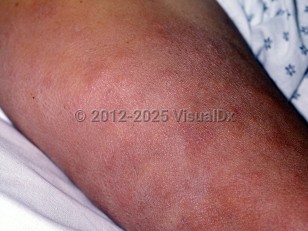Leprosy spreads via human-to-human transmission, but a prolonged (months-to-years) close contact with an infected person is needed to acquire the infection. Armadillos are also a reservoir. Per the US Centers for Disease Control and Prevention (CDC), in the southern United States, some armadillos are naturally infected with M leprae. Direct contact with armadillos is thought to be a risk factor for the development of leprosy. However, the risk is very low; 225 new cases were reported in the United States in 2023, mostly in Arkansas, California, Florida, Hawaii, Louisiana, New York, and Texas.
The average incubation period for M leprae is about 5 years, with a range from 2 years to over 30 years. Mycobacterium leprae has a predilection for the cooler parts of the body, skin, peripheral nerves, upper respiratory system, anterior eye chambers, and testes.
For ease of treatment, the World Health Organization (WHO) classifies leprosy into 2 types: paucibacillary (PB) and multibacillary (MB).
- PB cases involve only 1-5 skin lesions without demonstrated presence of bacilli in a skin smear.
- MB cases involve more than 5 skin lesions, or have nerve involvement with or without skin lesions. The demonstrated presence of bacilli in a slit-skin smear, irrespective of the number of skin lesions, is also considered MB leprosy.
- Tuberculoid leprosy (TT)
- Borderline tuberculoid leprosy (BT)
- Midborderline leprosy (BB)
- Borderline lepromatous leprosy (BL)
- Lepromatous leprosy (LL)
Peripheral neuropathy may occur across the spectrum before, during, and after treatment. Small nerve fibers conveying fine touch, temperature, and pain sensations are the most impaired. Motor nerve involvement can result in muscle weakness and disability. Immune instability (upgrading or downgrading reactions), fever, arthralgias, neurologic pain, uveitis, and orchitis may occur. Clinical presentation of the different types of leprosy are generally due to the response of the host to the bacilli rather than the direct damage from bacillary invasion.
Type 1 lepra reaction and erythema nodosum leprosum (type 2 lepra reaction) are 2 types of reactive states seen during alteration of the patient's immune response. They can occur before, during, or after therapy. Lucio phenomenon is a rare reaction seen in patients with MB leprosy due to endothelial invasion of M leprae.
Mycobacterium lepromatosis is a newly identified mycobacterium that has been reported to cause leprosy, Lucio phenomenon, and erythema nodosum leprosum.



